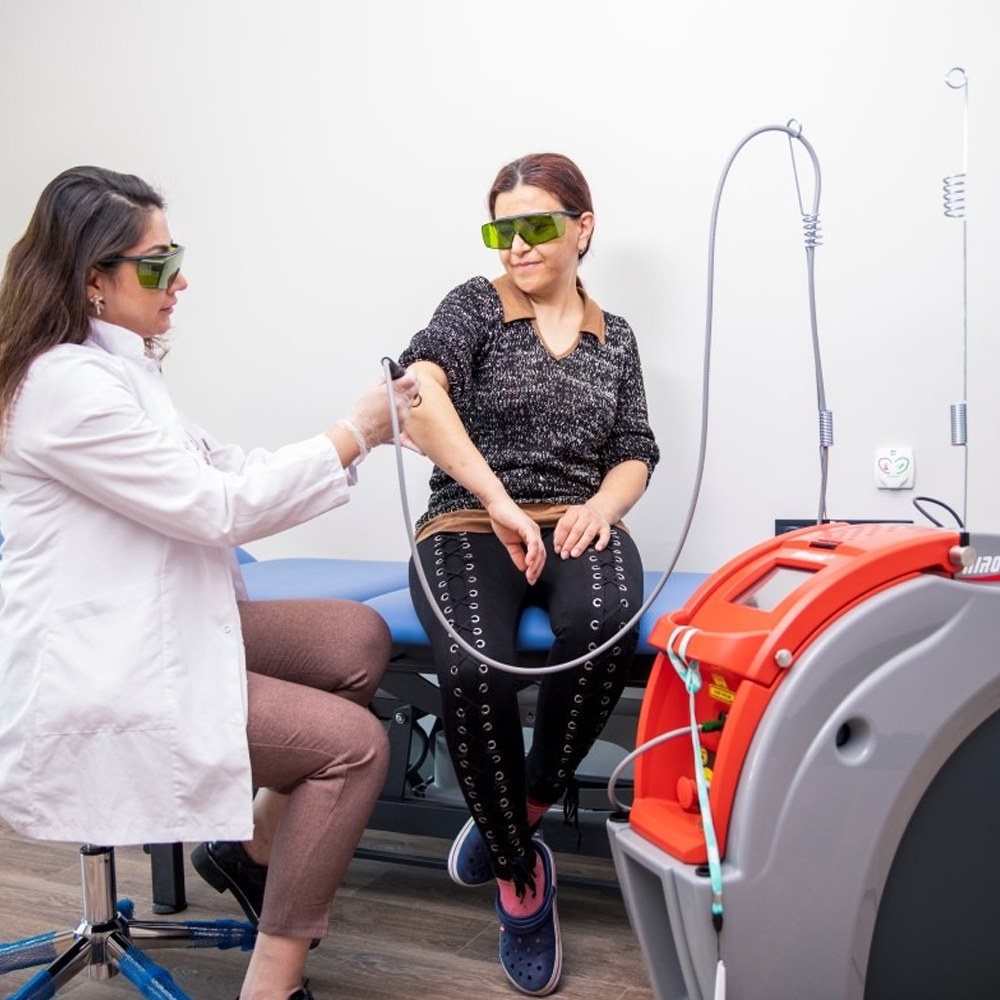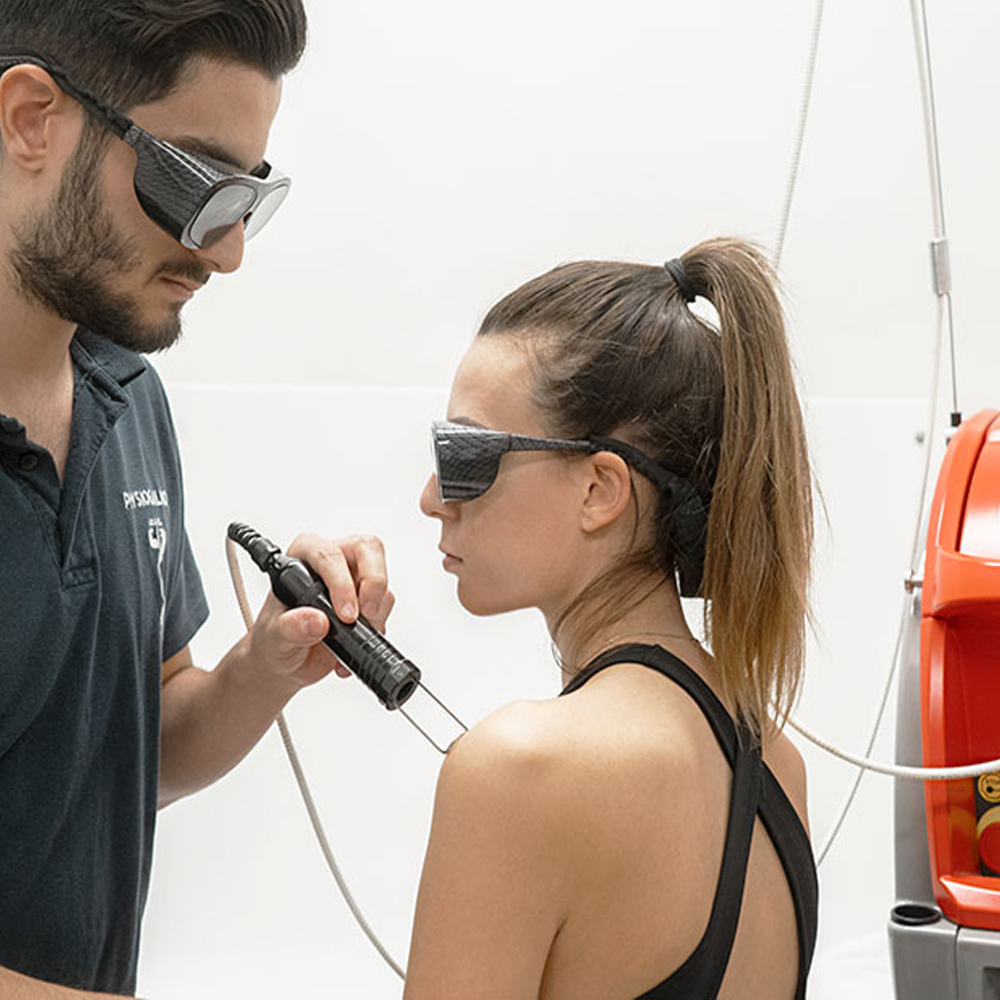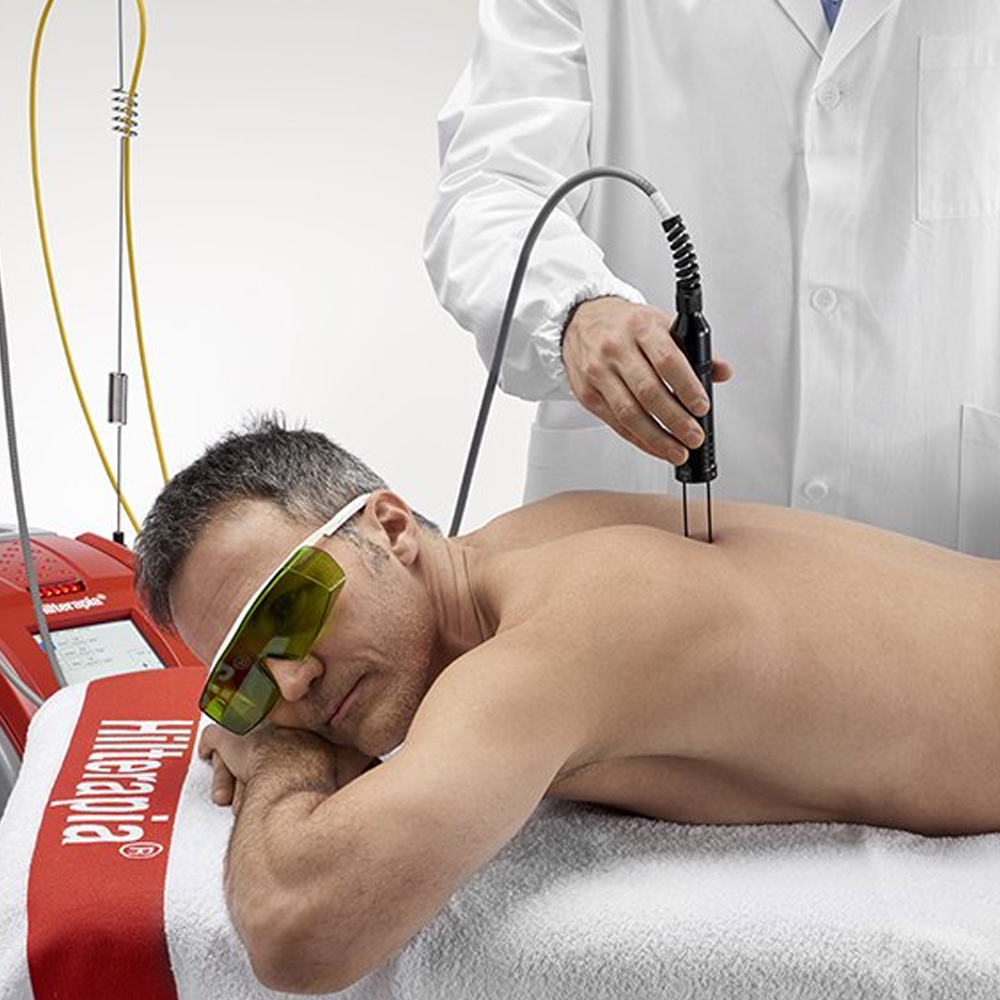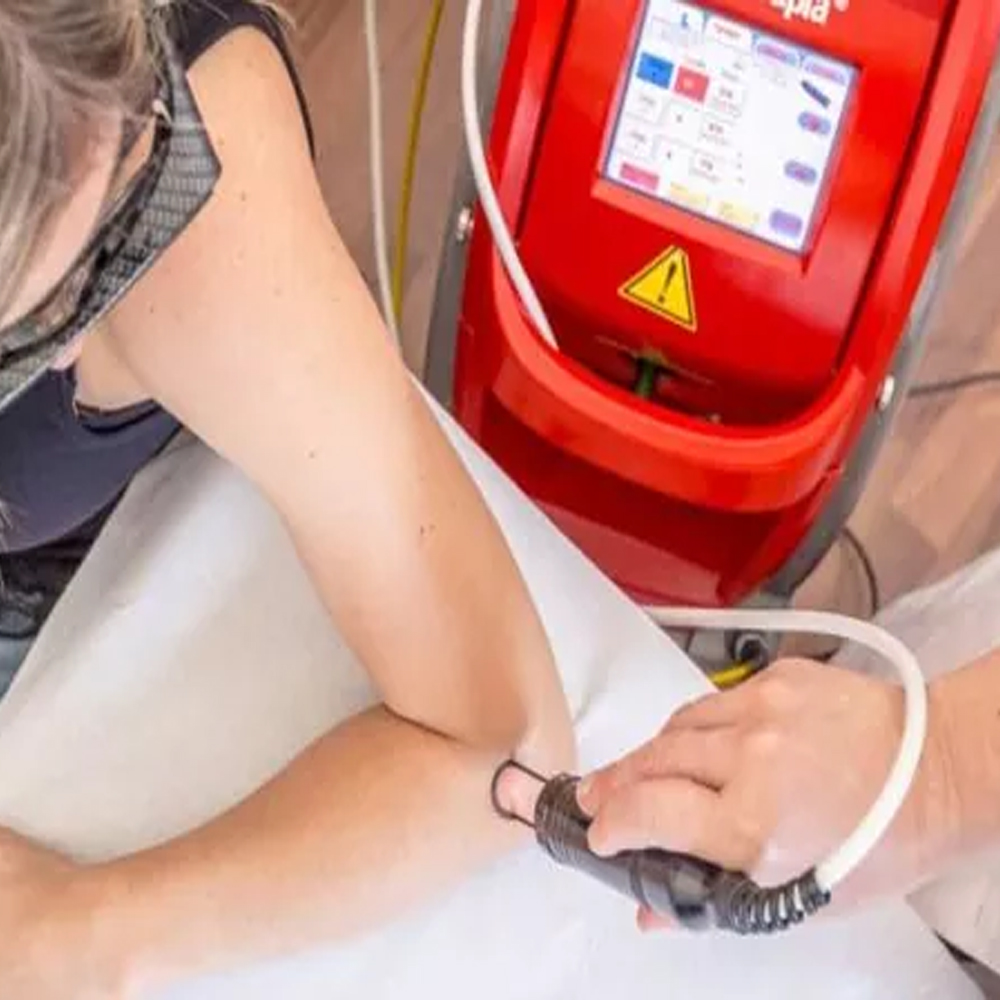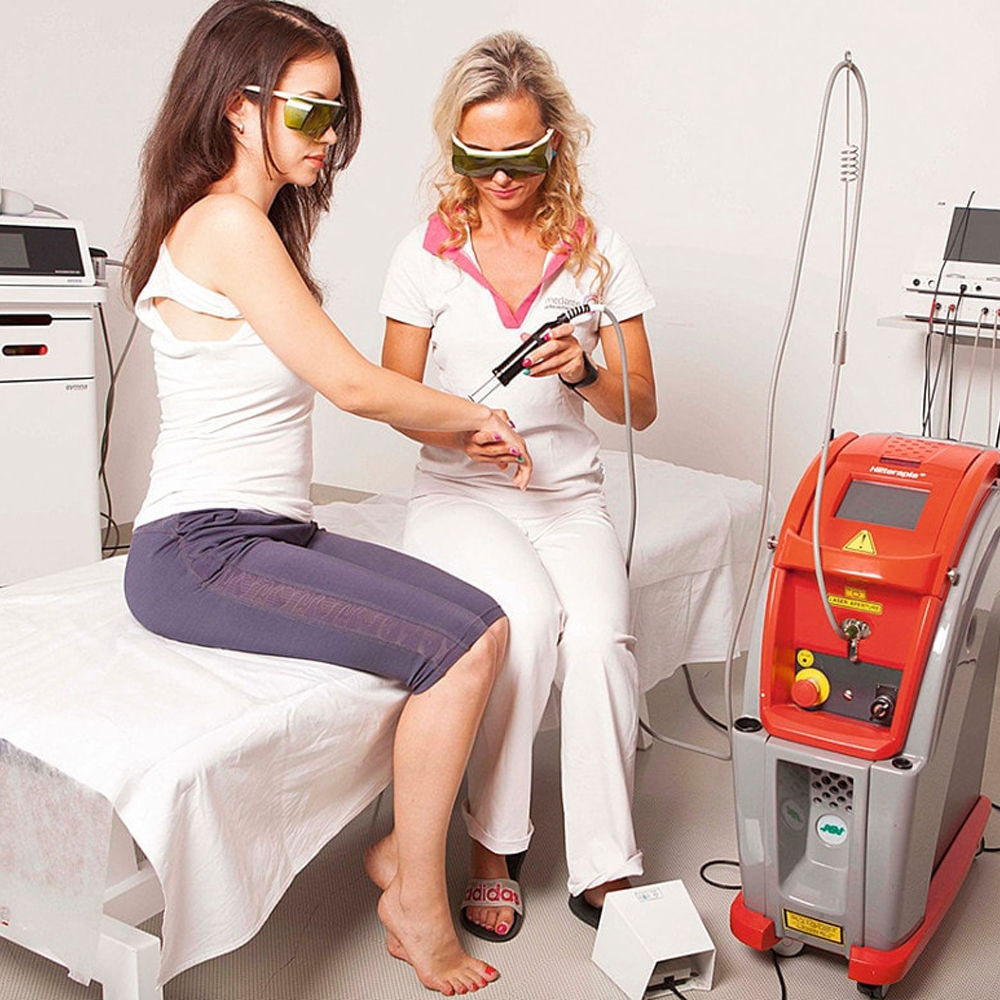Burtom ‣ Technologies ‣ High-Intensity Laser Therapy (HILT)
Language: 🇬🇧 English | 🇹🇷 Türkçe
High-Intensity Laser Therapy (HILT) Overview

 High-Intensity Laser Therapy (HILT) is an advanced medical treatment modality that utilizes high-energy laser beams to target specific areas of the body for therapeutic purposes. Unlike traditional low-level laser therapy (LLLT), which uses low-power lasers for superficial tissue treatment, HILT employs lasers with higher power densities to penetrate deeper into the tissues, reaching areas that are typically more difficult to access.
High-Intensity Laser Therapy (HILT) is an advanced medical treatment modality that utilizes high-energy laser beams to target specific areas of the body for therapeutic purposes. Unlike traditional low-level laser therapy (LLLT), which uses low-power lasers for superficial tissue treatment, HILT employs lasers with higher power densities to penetrate deeper into the tissues, reaching areas that are typically more difficult to access.
The fundamental principle behind HILT lies in its ability to deliver precise doses of laser energy to the affected tissues, where it interacts with cellular components to induce various physiological responses. This interaction triggers a cascade of biochemical reactions within the cells, leading to increased production of adenosine triphosphate (ATP), the primary energy source for cellular metabolism. This boost in ATP production enhances cellular function and accelerates the healing process by promoting tissue repair, reducing inflammation, and relieving pain.
One of the key advantages of HILT is its versatility and applicability across a wide range of medical conditions and therapeutic settings. It is commonly used in the management of musculoskeletal disorders, such as tendonitis, ligament injuries, arthritis, and muscle strains, as well as in sports medicine for the treatment of sports-related injuries and rehabilitation. Additionally, HILT has shown promising results in wound healing, post-surgical recovery, and pain management.
The treatment process typically involves the use of a handheld laser device that emits focused beams of high-energy light onto the targeted area of the body. The intensity, wavelength, and duration of the laser treatment can be customized based on the specific needs of the patient and the nature of the condition being treated. HILT is a non-invasive and painless procedure, making it well-tolerated by patients and suitable for use as both a standalone therapy and as part of a comprehensive rehabilitation program.
In summary, High-Intensity Laser Therapy offers a safe, effective, and non-invasive approach to pain relief, tissue healing, and rehabilitation. By harnessing the power of laser energy, HILT provides targeted treatment to address a wide range of medical conditions, making it a valuable tool in modern healthcare practice.
High-Intensity Laser Therapy (HILT): What Is It and How Does It Work?

High-Intensity Laser Therapy (HILT) utilizes concentrated light energy to stimulate tissue repair and alleviate pain. This non-invasive treatment works by penetrating deep into the targeted tissues, where it promotes cellular metabolism, accelerates healing processes, and reduces inflammation. The high-intensity laser emits photons, which are absorbed by the cells, leading to increased ATP production and the release of endorphins, promoting pain relief and tissue regeneration. By modulating cellular activity, HILT facilitates the repair of injured tissues, making it an effective option for various musculoskeletal conditions and injuries.
Cellular Effects of Laser Energy and Treatment Mechanism in High-Intensity Laser Therapy (HILT)
The cellular effects of laser energy in High-Intensity Laser Therapy (HILT) involve the stimulation of various biological processes within the cells. When laser energy is applied to tissues, it penetrates deep into the targeted area, where it interacts with chromophores (light-absorbing molecules) within the cells. This interaction leads to a series of photochemical reactions that result in the stimulation of cellular metabolism, increased production of adenosine triphosphate (ATP), and the release of nitric oxide (NO) and reactive oxygen species (ROS).
These cellular responses have several therapeutic effects, including:
- Acceleration of tissue repair and regeneration: Laser energy enhances cellular proliferation and migration, leading to faster wound healing and tissue regeneration.
- Reduction of inflammation: Laser therapy helps to decrease inflammatory mediators and cytokines, leading to a decrease in swelling, redness, and pain.
- Analgesic effects: By stimulating the release of endorphins and blocking pain signals, laser therapy provides pain relief and improves patient comfort.
The treatment mechanism of HILT involves the precise delivery of high-intensity laser energy to the target tissues. This energy is typically delivered using a handheld device equipped with a laser emitter. The device is placed in direct contact with the skin or positioned a short distance away, depending on the desired treatment depth.
During the treatment session, the laser emits a focused beam of light that penetrates the skin and reaches the underlying tissues. The energy is absorbed by the cells, where it initiates the aforementioned cellular responses. The duration and intensity of the laser treatment are carefully adjusted based on the specific condition being treated and the desired therapeutic outcome.
Applications and Importance of High-Intensity Laser Therapy (HILT)
HILT has a wide range of applications in various medical and rehabilitation settings due to its non-invasive nature and therapeutic benefits. Some common applications include:
- Musculoskeletal disorders: HILT is used to treat conditions such as tendonitis, bursitis, arthritis, and muscle strains.
- Sports injuries: Athletes often use HILT for the management of sports-related injuries, including sprains, strains, and overuse injuries.
- Pain management: HILT provides effective pain relief for conditions such as low back pain, neck pain, and neuropathic pain.
- Rehabilitation: HILT is used as part of rehabilitation programs to enhance tissue healing, improve range of motion, and reduce scar tissue formation.
Overall, the use of HILT offers patients a non-invasive, safe, and effective treatment option for a wide range of musculoskeletal conditions and injuries. Its ability to accelerate tissue repair, reduce inflammation, and alleviate pain makes it a valuable tool in modern healthcare practice.
The Basic Principle and Purpose of High-Intensity Laser Therapy (HILT)
High-Intensity Laser Therapy (HILT) operates on the principle of using concentrated laser energy to stimulate cellular processes and promote tissue healing. The primary purpose of HILT is to harness the therapeutic effects of laser energy to accelerate tissue repair, reduce inflammation, and alleviate pain. By delivering high-intensity laser energy to targeted areas, HILT aims to enhance cellular metabolism, increase ATP production, and stimulate the release of biochemical mediators that facilitate tissue regeneration and repair.
Treatment and Rehabilitation of Orthopedic Injuries
HILT is widely utilized in the treatment and rehabilitation of orthopedic injuries due to its ability to promote tissue healing and alleviate pain. In orthopedics, HILT is employed to address a variety of conditions, including fractures, sprains, strains, tendonitis, and arthritis. By delivering high-intensity laser energy to affected tissues, HILT helps to accelerate the healing process, reduce inflammation, and improve joint mobility.
In the context of orthopedic injuries, HILT plays a crucial role in rehabilitation programs aimed at restoring function and mobility. Through its ability to stimulate tissue repair and reduce pain, HILT facilitates the recovery process following orthopedic injuries, enabling patients to regain strength, flexibility, and range of motion. Additionally, HILT can be integrated into comprehensive rehabilitation protocols to optimize outcomes and expedite the return to normal activities.
Overall, HILT serves as an effective modality for the treatment and rehabilitation of orthopedic injuries by promoting tissue healing, reducing inflammation, and improving functional outcomes. Its non-invasive nature, combined with its therapeutic benefits, makes it a valuable tool in the management of orthopedic conditions and injuries.
Management of Muscle Injuries and Pain Syndromes
High-Intensity Laser Therapy (HILT) is utilized in the management of muscle injuries and pain syndromes due to its ability to promote tissue healing and alleviate pain. Muscle injuries, such as strains and tears, often result in pain, inflammation, and impaired function. HILT targets affected muscle tissues with concentrated laser energy, stimulating cellular processes that accelerate the healing process. By enhancing cellular metabolism, increasing ATP production, and reducing inflammation, HILT facilitates tissue repair and regeneration, leading to improved muscle function and pain relief.
Technology and Operating Principle of High-Intensity Laser Therapy (HILT)
HILT operates on the principle of utilizing high-intensity laser energy to stimulate cellular processes and promote tissue healing. The therapy involves the use of a high-powered laser device that emits concentrated light energy. When applied to targeted areas, the laser energy penetrates deep into the tissues, where it interacts with cellular components such as mitochondria and chromophores. This interaction triggers a cascade of biochemical reactions, including increased ATP production, enhanced cellular metabolism, and the release of growth factors that promote tissue repair and regeneration. The operating principle of HILT involves delivering precise doses of laser energy to targeted tissues, optimizing therapeutic effects while minimizing the risk of adverse reactions.
Clinical Applications of High-Intensity Laser Therapy (HILT)
High-Intensity Laser Therapy (HILT) has a wide range of clinical applications across various medical specialties. In addition to managing muscle injuries and pain syndromes, HILT is used in the treatment of orthopedic conditions, sports injuries, neurological disorders, and dermatological conditions. Clinical studies have demonstrated the effectiveness of HILT in promoting tissue healing, reducing inflammation, and alleviating pain in conditions such as tendonitis, arthritis, neuropathy, and fibromyalgia. HILT is often integrated into comprehensive treatment plans, complementing other modalities such as physical therapy, exercise, and medication. With its non-invasive nature and minimal side effects, HILT offers a safe and effective treatment option for patients seeking relief from musculoskeletal pain and dysfunction.
Advantages and Benefits of High-Intensity Laser Therapy (HILT)
High-Intensity Laser Therapy (HILT) offers several advantages and benefits in the management of various musculoskeletal conditions:
Non-Invasive: HILT is a non-invasive treatment modality that does not require incisions or injections, reducing the risk of complications and shortening recovery time.
Pain Alleviation: HILT has analgesic effects, providing effective pain relief by modulating pain signaling pathways and reducing inflammation.
Inflammation Reduction: HILT helps reduce inflammation by decreasing pro-inflammatory cytokines and promoting the resolution of inflammatory processes, contributing to faster healing.
Fast Healing and Tissue Repair Promotion: HILT stimulates cellular metabolism and enhances tissue repair mechanisms, leading to accelerated healing of injured tissues and faster recovery.
Versatility: HILT can be used to treat a wide range of musculoskeletal conditions, including tendonitis, muscle strains, ligament injuries, arthritis, and neuropathic pain, making it a versatile treatment option.
Minimal Side Effects: HILT is associated with minimal side effects and complications, making it a safe and well-tolerated therapy for patients of all ages.
Improved Functionality: By promoting tissue repair and reducing pain and inflammation, HILT improves joint mobility, muscle strength, and overall functional outcomes.
Risks and Side Effects of High-Intensity Laser Therapy (HILT)
While High-Intensity Laser Therapy (HILT) is generally considered safe, some potential risks and side effects may occur:
Skin Sensitivity: Some patients may experience mild skin sensitivity or redness at the treatment site, which typically resolves within a few hours.
Eye Protection: Laser therapy involves the use of high-intensity light, so eye protection is essential to prevent potential eye damage from direct exposure to the laser beam.
Rare Adverse Reactions: Although rare, allergic reactions or adverse effects such as blistering, bruising, or changes in skin pigmentation may occur in some individuals.
Contraindications: HILT may not be suitable for patients with certain medical conditions, such as active cancer, pregnancy, or photosensitivity disorders, so a thorough medical evaluation is necessary before treatment.
Treatment Response: While many patients experience significant pain relief and improvement in symptoms with HILT, individual responses to treatment may vary, and some patients may not achieve the desired outcomes.
Overall, the benefits of HILT in promoting pain relief, reducing inflammation, and accelerating tissue healing outweigh the potential risks for most patients. However, it is essential to discuss any concerns or questions with a healthcare provider before undergoing High-Intensity Laser Therapy.
Potential Complications and Precautions:
High-Intensity Laser Therapy (HILT) is generally safe when performed by trained professionals; however, there are potential complications and precautions to consider:
Eye Protection: Laser therapy involves the use of high-intensity light, which can be harmful to the eyes. Both the patient and the therapist must wear appropriate eye protection during the treatment session to prevent accidental eye exposure to the laser beam.
Skin Sensitivity: Some patients may experience mild skin sensitivity or redness at the treatment site following HILT. This is typically temporary and resolves within a few hours but should be monitored for any signs of irritation or allergic reactions.
Photosensitivity: Patients with photosensitive skin conditions or those taking photosensitizing medications should exercise caution when undergoing HILT, as laser therapy may exacerbate their condition or increase the risk of adverse reactions.
Contraindications: HILT may not be suitable for certain individuals with specific medical conditions or characteristics, including but not limited to:
- Active cancer or malignancy in the treatment area
- Pregnancy (especially in the abdominal or pelvic region)
- History of epilepsy or seizures
- Severe cardiovascular disorders
- Presence of metal implants or devices in the treatment area
A thorough medical evaluation should be conducted before initiating HILT to identify any contraindications and ensure the safety of the treatment.
Considerations During Treatment:
During High-Intensity Laser Therapy (HILT) sessions, several considerations should be taken into account to optimize treatment outcomes and minimize risks:
Proper Positioning: The patient should be positioned comfortably to ensure proper alignment and access to the treatment area. This may involve adjusting the treatment table or using supportive cushions to maintain a stable and relaxed position.
Treatment Parameters: The therapist should carefully select the appropriate laser parameters, including wavelength, power density, and treatment duration, based on the patient’s condition and treatment goals. Following recommended treatment protocols and guidelines can help achieve optimal therapeutic effects while minimizing the risk of adverse reactions.
Patient Monitoring: Throughout the treatment session, the therapist should closely monitor the patient’s response to HILT, including any changes in skin appearance, sensation, or discomfort. Open communication with the patient is essential to address any concerns or discomfort promptly.
Adjustments and Modifications: Depending on the patient’s response and tolerance to treatment, adjustments may be made to the laser parameters or treatment technique to ensure safety and effectiveness. This may involve modifying the treatment intensity, duration, or frequency as needed.
Post-Treatment Care: After completing HILT sessions, the therapist should provide appropriate post-treatment care instructions to the patient, including recommendations for skincare, activity modification, and follow-up appointments. Monitoring for any delayed or adverse reactions following treatment is important for ensuring patient safety and well-being.
Patient Experience and Comfort During High-Intensity Laser Therapy (HILT) Use:
During High-Intensity Laser Therapy (HILT) sessions, ensuring patient comfort and addressing their experience is essential for optimizing treatment outcomes and overall satisfaction. Several factors contribute to enhancing the patient experience and comfort during HILT use:
Communication: Effective communication between the therapist and the patient is crucial to address any concerns, explain the treatment process, and establish realistic expectations. Providing clear instructions and answering any questions can help alleviate anxiety and promote a sense of comfort and trust.
Environment: Creating a comfortable and relaxing treatment environment can contribute to the patient’s overall experience. This may include maintaining appropriate room temperature, minimizing noise and distractions, and ensuring adequate lighting.
Positioning: Proper positioning of the patient during HILT sessions is important for comfort and treatment effectiveness. Ensuring ergonomic support and using supportive cushions or bolsters can help maintain a comfortable posture and alleviate any discomfort during the session.
Monitoring and Adjustment: Throughout the treatment session, the therapist should continuously monitor the patient’s comfort level and adjust the treatment parameters or technique as needed. Open communication with the patient allows for real-time feedback, enabling the therapist to make necessary modifications to enhance comfort and optimize treatment outcomes.
Pain Management: High-Intensity Laser Therapy (HILT) is typically well-tolerated and non-invasive, but some patients may experience mild discomfort or sensitivity during treatment. The therapist can employ various pain management strategies, such as adjusting the treatment intensity or using topical analgesics, to minimize any discomfort and ensure a more comfortable experience for the patient.
Patient Impressions and Comfort During Treatment:
During High-Intensity Laser Therapy (HILT) sessions, patients’ impressions and comfort play a significant role in their overall treatment experience and satisfaction. Understanding and addressing patients’ perceptions and comfort levels can help improve treatment adherence and outcomes. Key considerations include:
Feedback: Encouraging patients to provide feedback on their treatment experience, including any discomfort or sensations they may experience, allows the therapist to adjust the treatment parameters or technique accordingly. Creating an open and supportive environment for communication fosters trust and collaboration between the patient and therapist.
Sensory Experience: Patients may have different sensory experiences during HILT, such as warmth or tingling sensations at the treatment site. Understanding and acknowledging these sensations can help reassure patients and alleviate any concerns they may have about the treatment process.
Comfort Measures: Incorporating comfort measures, such as providing supportive padding or adjusting the treatment position, based on patients’ feedback and comfort preferences can enhance their overall treatment experience. Empathetic listening and proactive adjustments contribute to a more comfortable and positive treatment environment.
Patient-Centered Care: Tailoring the treatment approach to meet the individual needs and preferences of each patient enhances their comfort and satisfaction during HILT sessions. Considering factors such as pain tolerance, treatment goals, and personal preferences ensures a patient-centered approach that prioritizes their well-being and comfort throughout the treatment process.
Follow-Up and Support: Following HILT sessions, providing ongoing support and follow-up care reinforces patients’ comfort and satisfaction with the treatment experience. Addressing any post-treatment concerns or questions and offering guidance on post-treatment care promotes a sense of confidence and reassurance for patients.
Post-Treatment Recovery and Patient Satisfaction:
Post-treatment recovery and patient satisfaction are crucial aspects of the overall treatment process in High-Intensity Laser Therapy (HILT). Ensuring a smooth and effective recovery period contributes to patient satisfaction and enhances treatment outcomes. Key considerations for post-treatment recovery and patient satisfaction in HILT include:
Monitoring and Follow-Up: After completing HILT sessions, monitoring patients’ progress and providing follow-up care are essential for assessing treatment effectiveness and addressing any lingering symptoms or concerns. Regular follow-up appointments allow therapists to track recovery progress, address any issues that may arise, and ensure patient satisfaction with the treatment outcomes.
Rehabilitation and Maintenance: Incorporating post-treatment rehabilitation exercises or protocols tailored to each patient’s needs supports ongoing recovery and promotes optimal outcomes. Providing guidance on home exercises, activity modification, and lifestyle adjustments empowers patients to actively participate in their recovery process and maintain the benefits of HILT treatment.
Pain Management: Managing post-treatment discomfort or pain, if present, is important for patient comfort and satisfaction. Educating patients on pain management strategies, such as applying ice or heat therapy, using over-the-counter pain relievers as needed, and following prescribed rehabilitation protocols, helps alleviate discomfort and enhances overall satisfaction with the treatment process.
Patient Education: Offering comprehensive patient education regarding post-treatment expectations, potential side effects, and self-care strategies fosters informed decision-making and empowers patients to take an active role in their recovery. Providing written instructions or educational materials reinforces key concepts and supports patients in navigating their post-treatment recovery journey.
Emotional Support: Addressing patients’ emotional well-being and providing emotional support during the post-treatment recovery period contributes to overall patient satisfaction and well-being. Offering empathetic listening, encouragement, and reassurance can help alleviate anxiety or concerns and promote a positive outlook on recovery.
Patient Rights and Considerations Regarding High-Intensity Laser Therapy (HILT):
Respecting and upholding patient rights and considerations are fundamental principles in the delivery of High-Intensity Laser Therapy (HILT). Recognizing and addressing patients’ rights, preferences, and ethical considerations ensures a patient-centered approach to care. Key aspects of patient rights and considerations regarding HILT include:
Informed Consent: Obtaining informed consent from patients before initiating HILT treatment is essential, ensuring that patients understand the treatment process, potential benefits, risks, and alternatives. Providing comprehensive information enables patients to make informed decisions about their care and treatment options.
Confidentiality and Privacy: Protecting patient confidentiality and privacy is paramount in HILT practice. Safeguarding patient health information, maintaining secure record-keeping practices, and adhering to applicable privacy regulations uphold patient confidentiality and trust in the therapeutic relationship.
Respect for Autonomy: Respecting patients’ autonomy involves acknowledging their right to make decisions about their care based on their values, preferences, and goals. Involving patients in treatment planning, discussing treatment options, and respecting their choices support autonomy and shared decision-making in HILT.
Non-Discrimination: Ensuring equitable access to HILT treatment and services without discrimination based on factors such as age, gender, race, ethnicity, religion, disability, or socioeconomic status upholds principles of fairness and inclusivity in healthcare delivery.
Ethical Practice: Practicing HILT in an ethical manner involves upholding professional standards, integrity, and accountability in all aspects of patient care. Adhering to ethical guidelines, maintaining professional boundaries, and prioritizing patient well-being demonstrate a commitment to ethical practice in HILT.
By honoring patient rights and considerations and adhering to ethical principles, therapists can provide patient-centered care that respects individual autonomy, fosters trust, and promotes positive treatment outcomes in High-Intensity Laser Therapy (HILT).
Privacy and Data Protection:
Ensuring privacy and data protection is paramount in the context of High-Intensity Laser Therapy (HILT) to safeguard patient confidentiality and uphold ethical standards in healthcare. Key considerations for privacy and data protection in HILT include:
Confidentiality Measures: Implementing robust confidentiality measures, such as secure record-keeping systems, encryption of electronic data, and restricted access to patient information, helps prevent unauthorized access or disclosure of sensitive patient data.
Compliance with Regulations: Adhering to relevant privacy regulations and healthcare laws, such as the Health Insurance Portability and Accountability Act (HIPAA) in the United States or the General Data Protection Regulation (GDPR) in the European Union, ensures compliance with legal requirements for protecting patient privacy and data security.
Patient Consent: Obtaining informed consent from patients regarding the collection, use, and disclosure of their personal health information for HILT treatment purposes is essential. Clearly explaining the purposes of data collection and obtaining explicit consent from patients empower them to make informed decisions about their privacy rights.
Data Encryption and Storage: Employing encryption techniques and secure storage protocols for patient data, both during transmission and storage, helps mitigate the risk of data breaches and unauthorized access. Utilizing encrypted communication channels and secure data servers enhances data security in HILT practice.
Training and Awareness: Providing training and education to healthcare professionals involved in HILT regarding privacy best practices, data security protocols, and patient confidentiality guidelines fosters a culture of privacy awareness and compliance within the healthcare setting.
Patient Rights and Preferences During Treatment:
Respecting patient rights and preferences during High-Intensity Laser Therapy (HILT) treatment is essential for promoting patient autonomy, dignity, and satisfaction with care. Key considerations for patient rights and preferences during HILT treatment include:
Informed Decision-Making: Empowering patients to actively participate in treatment decision-making by providing comprehensive information about HILT, including potential benefits, risks, alternatives, and expected outcomes. Engaging in shared decision-making processes that consider patients’ values, preferences, and treatment goals promotes patient-centered care in HILT.
Respect for Dignity and Autonomy: Upholding patients’ dignity and autonomy by respecting their preferences, cultural beliefs, and personal values throughout the treatment process. Respecting patients’ choices regarding treatment options, privacy preferences, and involvement in care decisions supports a patient-centered approach to HILT.
Communication and Collaboration: Establishing open and transparent communication channels between patients and healthcare providers involved in HILT treatment facilitates effective information sharing, mutual understanding, and collaborative decision-making. Encouraging patients to express their concerns, preferences, and questions fosters a supportive therapeutic relationship and enhances patient satisfaction.
Privacy and Comfort: Ensuring patients’ privacy and comfort during HILT treatment by providing appropriate facilities, maintaining confidentiality, and respecting patients’ modesty and personal boundaries. Respecting patients’ preferences regarding the presence of caregivers or companions during treatment contributes to their sense of comfort and well-being.
Consent and Refusal: Respecting patients’ right to provide informed consent or refuse treatment based on their individual preferences, values, and beliefs. Honoring patients’ decisions regarding treatment acceptance or refusal supports their autonomy and right to make choices about their healthcare in HILT.
Future Applications and Development of High-Intensity Laser Therapy (HILT):
The future applications and development of High-Intensity Laser Therapy (HILT) hold promising potential for advancing treatment options and enhancing patient care in various healthcare settings. Key areas of focus for future applications and development of HILT include:
Advanced Technology Integration: Incorporating advanced technological innovations, such as novel laser delivery systems, customizable treatment protocols, and real-time monitoring tools, into HILT practice to optimize treatment outcomes, improve treatment precision, and enhance patient safety and comfort.
Evidence-Based Research: Conducting rigorous scientific research and clinical trials to further evaluate the efficacy, safety, and optimal parameters of HILT across a wide range of medical conditions and patient populations. Generating robust evidence-based data supports the expansion of HILT applications and informs clinical practice guidelines.
Multidisciplinary Collaboration: Fostering multidisciplinary collaboration and integration of HILT into comprehensive healthcare models involving various healthcare professionals, including physicians, physical therapists, rehabilitation specialists, and pain management specialists. Collaborative care approaches facilitate holistic patient management and maximize the benefits of HILT across different healthcare disciplines.
Personalized Treatment Approaches: Developing personalized treatment approaches and individualized HILT protocols tailored to patients’ unique clinical profiles, preferences, and treatment goals. Emphasizing personalized care delivery optimizes treatment effectiveness, enhances patient satisfaction, and promotes patient-centered outcomes in HILT practice.
Accessibility and Affordability: Increasing accessibility and affordability of HILT treatments by exploring innovative delivery models, expanding insurance coverage, and reducing treatment costs. Addressing barriers to access, such as geographical limitations and financial constraints, ensures equitable distribution of HILT services and promotes healthcare equity and inclusivity.
By focusing on these areas of future development and innovation, High-Intensity Laser Therapy (HILT) can continue to evolve as a valuable therapeutic modality with expanded applications, improved outcomes, and enhanced patient-centered care in the healthcare landscape.
Frequently Asked Questions

Get a Free Second Opinion
Experienced Burtom Medical Team is Ready to Help

I consent to Burtom Health Group using my aforesaid personal data for the purposes described in this notice and understand that I can withdraw my consent at any time by sending a request to info@burtom.com.
